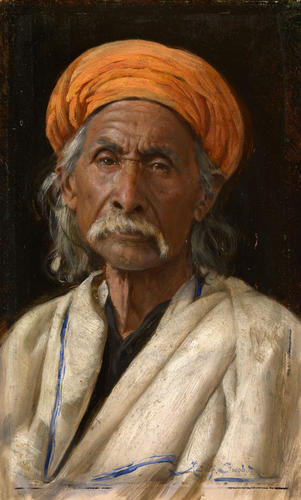-
1 of 253523 objects
Bakshiram 1886
Oil on panel | 26.0 x 15.6 x 0.4 cm (support, canvas/panel/stretcher external) | RCIN 403826

Rudolf Swoboda (1859-1914)
Bakshiram 1886
-
This was one of eight portraits painted by Swoboda of participants of the Colonial and Indian Exhibition in South Kensington, London, in 1886. Bakshiram was a potter, alleged to be over 102 years old, from Agra in India. On the 4 May 1886, the Globe reported that the Queen opened the exhibition and as she progressed through the displays …’Here on the approach of an old and enfeebled man, the Queen stopped, and listened courteously to an address in Hindostanee addressed by the venerable Baksh-Iram, an Indian craftsman, whose age is said to be 102.’
Rudolf Swoboda was born in Vienna in 1859 and studied under his uncle Leopold Carl Müller between 1878 and 1884. Between 1885 and 1892 Swoboda worked for Queen Victoria. On the 7 October 1886 he travelled to India, passing through Afghanistan and Kashmir on route, to undertake a commission from the sovereign. Queen Victoria paid for his passage and gave him £300 to cover his travelling expenses. In return he was to provide the Queen with sketches worth £300. The Queen gave Swoboda specific instructions: 'The Sketches Her Majesty wishes to have – are of the various types of the different nationalities. They should consist of heads of the same size as those already done for The Queen, and also small full lengths, as well as sketches of landscapes, buildings, and other scenes.’
Swoboda was first introduced to Queen Victoria in 1885 by the respected court artist Heinrich von Angeli: ‘Saw a young Austrian Artist recommended by Angeli’ she recorded in her Journal on 22 April 1886. ‘He is only twenty-six, of the name of Swoboda, & is full of talent.’ And in the spring of that year the artist received one of his first commissions from the Queen - he was to paint eight portrait heads of ‘native artisans’ attending the Colonial and Indian exhibition in London – a six-month display of colonial culture and commerce, and a demonstration of British imperial power that coincided with Queen Victoria’s Jubilee. The sitters formed part of the ‘living displays’ of artisans demonstrating ‘traditional’ crafts such as weaving, pottery and carving and included five Indians; a Cypriot weaver, Rhodothea Petrou; the Malay dressmaker, Georgina Manan; and John Kabua Silos, a ploughman and diamond washer from South Africa (RCINs 403822, 403823, 403824, 403826, 403828,403752, 403751, 403790).
Amongst the Indian sitters were the stonemason Radha Ballabh; 9-year-old Ramlal, a child carpet weaver; and Bakshiram, an aged potter said to be 102 years old (RCINs 403822, 403823, 403826). The research of Saloni Mathur in 2002 for an exhibition at the National Gallery, London and expanded in her 2007 book documented that many of the ‘native artisans’ were selected from the Central Gaol at Agra by Dr John William Tyler, the superintendent of the prison, who accompanied them to London. Their training in so-called ‘traditional’ craft skills, such as weaving and carpet-making, during their time in prison formed part of a reform and rehabilitation programme which purported to instil a work ethic and allowed them to acquire a trade which might be useful on their release. (S Mathur, India by Design: Colonial History and Cultural Display, 2007). It is unclear whether the inmates travelled voluntarily or under the conditions of their sentence, although Mathur records that they received a wage, which was half paid to them in advance and half retained until their return.
A large carpet sent to Windsor Castle in 1894 was made inmates of the same gaol as part of a prison reform programme (RCIN 35837). This export and display in Europe was not unusual - from the 1850s, prison-made carpets featured regularly at international and domestic exhibitions, as well as in Indian museums.
Like all Royal Collection records, this object is subject to ongoing research. Royal Collection Trust welcomes further information relating to the identity of the person depicted in this portrait.
Signed lower right: Rudolf Swoboda.Provenance
Commissioned by Queen Victoria
-
Creator(s)
-
Medium and techniques
Oil on panel
Measurements
26.0 x 15.6 x 0.4 cm (support, canvas/panel/stretcher external)
40.2 x 30.0 x 2.5 cm (frame, external)
Other number(s)
Alternative title(s)
Bakshiram, a potter from Agra alledged to be over 102 years old
Ruxshiram, previously entitled